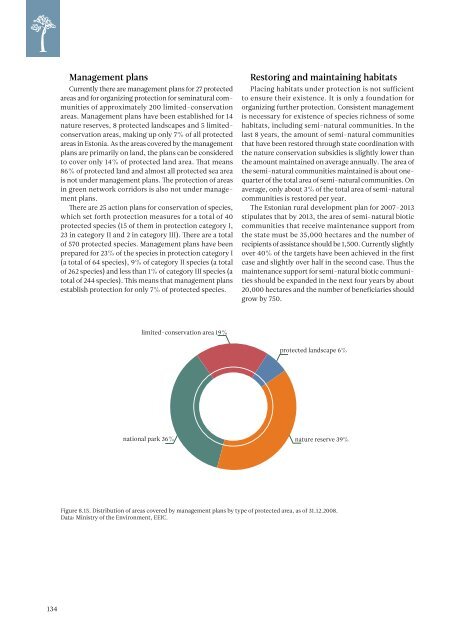ESTONIAN ENVIRONMENTAL REVIEW 2009
ESTONIAN ENVIRONMENTAL REVIEW 2009
ESTONIAN ENVIRONMENTAL REVIEW 2009
You also want an ePaper? Increase the reach of your titles
YUMPU automatically turns print PDFs into web optimized ePapers that Google loves.
Management plans<br />
Currently there are management plans for 27 protected<br />
areas and for organizing protection for seminatural communities<br />
of approximately 200 limited-conservation<br />
areas. Management plans have been established for 14<br />
nature reserves, 8 protected landscapes and 5 limitedconservation<br />
areas, making up only 7% of all protected<br />
areas in Estonia. As the areas covered by the management<br />
plans are primarily on land, the plans can be considered<br />
to cover only 14% of protected land area. That means<br />
86% of protected land and almost all protected sea area<br />
is not under management plans. The protection of areas<br />
in green network corridors is also not under management<br />
plans.<br />
There are 25 action plans for conservation of species,<br />
which set forth protection measures for a total of 40<br />
protected species (15 of them in protection category I,<br />
23 in category II and 2 in category III). There are a total<br />
of 570 protected species. Management plans have been<br />
prepared for 23% of the species in protection category I<br />
(a total of 64 species), 9% of category II species (a total<br />
of 262 species) and less than 1% of category III species (a<br />
total of 244 species). This means that management plans<br />
establish protection for only 7% of protected species.<br />
Restoring and maintaining habitats<br />
Placing habitats under protection is not sufficient<br />
to ensure their existence. It is only a foundation for<br />
organizing further protection. Consistent management<br />
is necessary for existence of species richness of some<br />
habitats, including semi-natural communities. In the<br />
last 8 years, the amount of semi-natural communities<br />
that have been restored through state coordination with<br />
the nature conservation subsidies is slightly lower than<br />
the amount maintained on average annually. The area of<br />
the semi-natural communities maintained is about onequarter<br />
of the total area of semi-natural communities. On<br />
average, only about 3% of the total area of semi-natural<br />
communities is restored per year.<br />
The Estonian rural development plan for 2007–2013<br />
stipulates that by 2013, the area of semi-natural biotic<br />
communities that receive maintenance support from<br />
the state must be 35,000 hectares and the number of<br />
recipients of assistance should be 1,500. Currently slightly<br />
over 40% of the targets have been achieved in the first<br />
case and slightly over half in the second case. Thus the<br />
maintenance support for semi-natural biotic communities<br />
should be expanded in the next four years by about<br />
20,000 hectares and the number of beneficiaries should<br />
grow by 750.<br />
limited-conservation area 19%<br />
protected landscape 6%<br />
national park 36%<br />
nature reserve 39%<br />
Figure 8.15. Distribution of areas covered by management plans by type of protected area, as of 31.12.2008.<br />
Data: Ministry of the Environment, EEIC.<br />
134

















